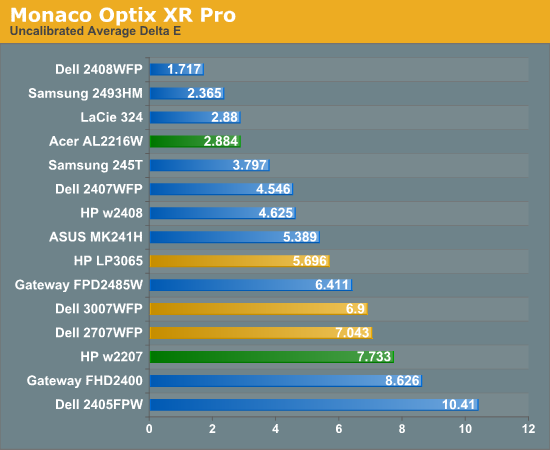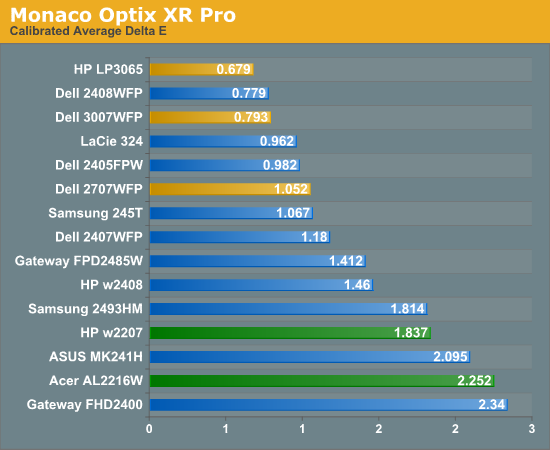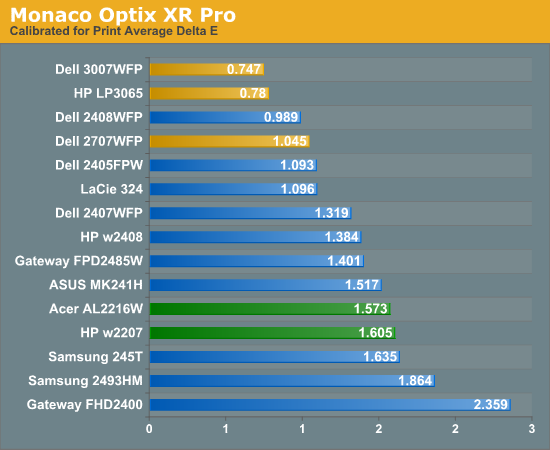Color Accuracy
Imaging professionals definitely like to have accurate colors, and the best way of assuring that your display shows the proper colors is to use a colorimeter and calibration software. However, not everyone has access to such tools and many users are unwilling to spend over $200, so we test before and after calibration. (Put more accurately, we calibrate the monitors and then tweak the created profile back to an uncalibrated state so that we can evaluate the performance of the display in its default state.) For calibration, we target a white level of 250 nits -- anything more than that is too bright in our opinion. We also do a second calibration targeting a white level of 100 nits, which would be useful when working on material that will end up in print form. Before we get the results, here are the display settings we used on the test LCDs. We let the LCDs stabilized for at least one hour before performing measurements.
| LCD Brightness and Contrast Settings | ||
| Standard Calibrated (~250 nits) | Calibrated for Print (~100 nits) | |
| ASUS MK241H | 45 Brightness, 80 Contrast 100-100-100 RGB |
50 Brightness, 80 Contrast 54-51-73 RGB |
| Dell 2408WFP | 50 Brightness, 50 Contrast 80-80-80 RGB |
48 Brightness, 50 Contrast 55-55-55 RGB |
| Gateway FHD2400 | 70 Brightness, 70 Contrast 76-77-92 RGB |
50 Brightness, 50 Contrast 57-57-70 RGB |
| LaCie 324 | 35 Brightness, 0 Contrast 128-128-128 RGB 2.2 Gamma, 6500K |
7 Brightness, 0 Contrast 128-128-128 RGB 2.2 Gamma, 6500K |
| Samsung 2493HM | 60 Brightness, 75 Contrast 100-100-100 RGB |
28 Brightness, 75 Contrast 46-37-65 RGB |



Starting with the uncalibrated results, it's pretty easy to see why we feel calibration tools are necessary for most users. This is not to say that you can't be happy with inaccurate colors -- your eyes will compensate, and some people prefer warmer (redder) or cooler (bluer) tones. However, if you're doing work with images or video as an example, it is important that what you see on your display matches as much as possible what others will see on their displays. Of the tested LCDs, only four are able to achieve an average Delta E of less than 3.0 without calibration -- three of which happen are part of this roundup. That's encouraging, as it indicates LCD manufacturers may be spending a bit of extra time to ensure that at least one of the settings will provide neutral, accurate colors. The real shocker however is the Dell 2408WFP. Its uncalibrated Delta E reaches an exceptional 1.7 -- a score that's better than several of the LCDs after calibration!
With calibration, all the scores improve substantially, but anyone serious about color accuracy is probably going to want an average Delta E of around 1.0 or less after calibration. Of the tested monitors, the 24" Dell displays (all three models that we've tested), the LaCie 324, and the two 30" LCDs all manage to accomplish this, along with the Dell 2707WFP and Samsung 245T. Switching to appropriate "printing" settings puts the three largest LCDs at the top of the charts, along with the Dell 2408WFP (and the old 2405FPW) and LaCie 324.
Most of the LCDs in this roundup place in the middle or upper portion of the above graphs, with one exception. The Gateway FHD2400 comes in last or in second to last in all three tests. We actually really like the Gateway display for many of its features, but in terms of color accuracy it is definitely lacking. We spent a substantial amount of time trying to tweak the settings in order to achieve better results, all to no avail. There's more to LCDs than color accuracy, of course, and the price and appearance might be enough to help you overlook the relatively poor performance here.










89 Comments
View All Comments
JarredWalton - Tuesday, May 6, 2008 - link
But that's exactly what I did in this review. Unless you mean a high-speed video camera that can record the changes in response to external stimuli (i.e. someone clicking a mouse).I think way too many people are losing sight of the forest because they're obsessing over the trees. I've given relative input lag, and it's accurate to 10ms for sure (and with averaging it should be accurate to around 3ms). At some point I may find an LCD that has a negative lag relative to the HP LP3065, and that's fine. As it stands, the best LCDs equal that LCD's lag.
Input lag as a whole is only one consideration of a display purchase, and differences of 3ms (or even 10ms) are not going to make you suddenly superior in games. 50ms? Sure, that's a potential problem, but anyone who has played online FPS games competitively knows that you have to learn to anticipate in order to compensate for network lag that may be anywhere from 50 to 150ms even with a high-speed connection.
If you want a display that offers minimal processing lag, so far the TN panels and 30" LCDs do great. I'd assume all the 22" LCDs do reasonably well, but having none in house at present I can't say for sure. Then everyone with S-PVA panels can call you an LPB.
jmunjr - Friday, May 2, 2008 - link
Though there are reports it now uses a TN panel, I am disappointed the Soyo Topaz S was not in this review. A bare bones S-PVA monitor for as low as $250 and easily $300 with no rebates? Ring me up! I have one and for the price it cannot be beat - period. At 24" TN monitors have too many shortcomings.bupkus - Friday, May 2, 2008 - link
I read this article this morning and then my gf calls me an tells me she has a $100 Dell credit that expires tonight.I thought, why not sell my Samsung SyncMaster 225BW and get this UltraSharp 2408? Starting Price... $679.00, that's why.
However, the E248WFP is on sale for $379.00. How does that compare?
Dashel - Friday, May 2, 2008 - link
Count me among those who want to know if it's even possible a revision will address the input lag on the Dell 2408. That's all that is holding me back from buying this monitor.Can they even get it down to 2407 input lag levels?
Finally BenQ G2400W, see if they wont give you one to review! That's my back up plan if the Dell doesnt pan out ;)
JarredWalton - Friday, May 2, 2008 - link
The best S-PVA panel has a 20ms lag on average. Note also that the Gateway FPD2485W uses a Faroudja chip and ends up with 20ms while the TN FHD2400 uses a Faroudja and gets ~0ms and LaCie does the same and gets 40ms. My guess is that somehow in the interest of colors or something else the S-PVA tech is delaying what you see on the LCD. The built-in scalers may also be inducing some delay, but the TN panels have scalers as well and don't suffer from any lag.Dashel - Saturday, May 3, 2008 - link
Isnt the 2407 an S-PVA as well though? You'd think they'd be able to at least match that level of input lag. That'd be enough to make me confident enough to buy one.As it stands, I'll have to see what revision A01 brings. I'll probably get one anyway. No 24" seems to have everything I want sadly. Good gaming non TN panel with plenty of inputs. The 2408 or that DoubleSight seems to come closest.
GTVic - Friday, May 2, 2008 - link
I would like to know if it is possible for game developers or hw manufacturers to develop controls in the games or in the driver control panel that would allow an adjustment for input lag. That way if you know you have a certain lag you can tell the game/driver to compensate.PPalmgren - Friday, May 2, 2008 - link
I highly doubt this would be possible.When I first hooked up my NEC 2470WNX, I played some DotA in (a Warcraft 3 map) and noticed after 5 minutes that I couldn't click on anything as well as usual. The funny thing is this isn't really aim-intensive, being an FPS. I tested it out and realized my mouse's response was delayed on the screen. I then noticed the same problem playing BF2 and NS a day later. It becomes impossible to aim quickly because you aim based on where your cursor is visible. However, your cursor is not where you see it on the screen, its still moving. Its a constant fight of over-compensation ruins your gameplay. The next week, I put my old Viewsonic 19' back up and still use it for games. I STRONGY suggest buying a TN panel for games, having experienced the short end of the stick.
GTVic - Friday, May 2, 2008 - link
I think it certainly should be possible.There a maybe a few types of lag. One is due to an overloaded graphics card that is not able to draw enough frames per second to properly update your mouse position so you don't know what you are shooting at. There is nothing to be done about that except buy a better graphics card or reduce the resolution/quality.
The other type of lag is when the game thinks one frame is being displayed and due to delays down the chain an older frame is being displayed. The game records your mouse click (gun fire) and calculates whether you hit the target based on the wrong frame.
The lag is not enough to cause the audio to be out of sync but if the game knew that the display was constantly 3 frames behind then it should be possible to correct the problem. Would be nice if Jared could investigate that with ATI/nVidia/game devs.
Dainas - Friday, May 2, 2008 - link
Oh you don't have to go to TN, I have two 24" P-MVAs that suffer from none of the blatant lag in the aforementioned panels. Both are verifiably faster than the 20ms 2407wfp and coming from a CRT I had none of the loose feeling in fast FPS like CS:Source and CoD4. All these slow panels are more in the realm of 40ms.need only look at this to know TNs do not have an unavoidable technical advantage over VA panels and its likely the manufactures putting IQ over response in most cases ;
http://www.digitalversus.com/article-357-3215-303....">http://www.digitalversus.com/article-357-3215-303....
But then again considering these panels are dissapearing from the market one might have to go TN afterall for gaming.